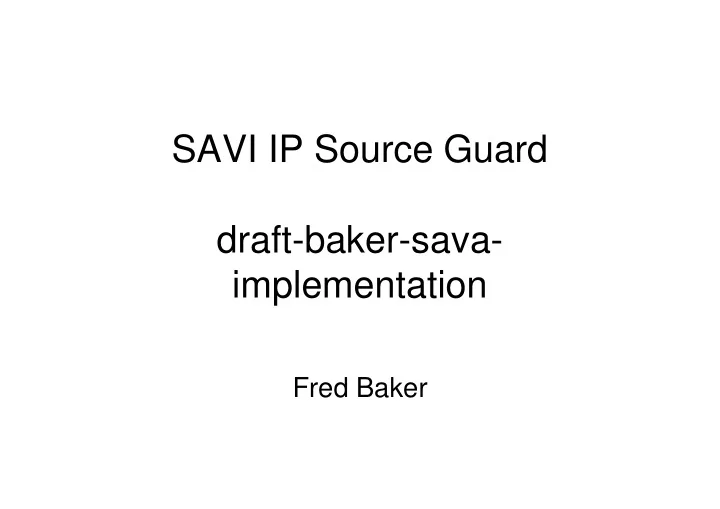

SAVI IP Source Guard draft-baker-sava- draft-baker-sava- implementation Fred Baker
Cases covered in the draft • Draft specifies IPv6, could include IPv4 • Network cases: Switched LANs and access networks Switched LANs and access networks Protect in switch Non-switched LANs and access networks Protect neighboring host and router from peers Upstream router Traditional ingress filtering
Premises: • Addresses assigned using DHCP or SAA • Multiple addresses per interface • On interfaces with sub-interfaces such as VLANs, the sub-interface is under discussion VLANs, the sub-interface is under discussion • Host has one interface That said, see draft-baker-6man-multiprefix-default- route Proposes separate default routes/default gateways by source address One could protect more cases with that model
Trust Anchors • The key is to associate an IP address with a stable lower layer entity or set of entities: – Physical or logical port – 802.11 radio association – Ethernet MAC Address – Virtual circuit or other tunnel • Every link layer has trust anchors that can be used for network layer address verification
Algorithm for switched LANs Don’t Love Joy Peace Ask • Implement in the switch • Snoop Neighbor Discovery – DHCP or SAA assignment – ND or SeND negotiation – ND or SeND negotiation solicit – Yes, that’s a layer violation. response • Autoconfigure port or port+MAC filter on Solicitation/Response exchange – Discard IP traffic that doesn’t use properly negotiated addresses • Routers still can’t be protected DHCP optional
Algorithm for non-switched LANs Don’t Love Joy Peace Ask • Implement in host/router • Use Neighbor Discovery Tables – DHCP or SAA assignment – ND or SeND negotiation – ND or SeND negotiation solicit • Autoconfigure address:anchor filter response in hosts/routers on Solicitation/Response exchange – Discard IP traffic that doesn’t use properly negotiated addresses • Routers: – Hosts still can’t be protected against routers – Routers can protect themselves from rogue hosts DHCP optional
Defense in Depth: Upstream Router • Essential concept: – If neighbor is legitimately advertising a prefix to you, you a prefix to you, you • At administrative • At administrative might legitimately boundaries, it is receive traffic from that wise to verify prefix address usage to – If he’s not, you probably the extent possible shouldn’t • BCP 38/RFC 2827 ingress filtering still valuable
The snaky case • Hosts may have multiple interfaces without routing between them. – Hosts send “from” the IP address of the interface they request on. – Hosts respond “from” the IP address the request was sent address the request was sent to – Host routing may not send data back the way it came • Implication: – Hosts with multiple interfaces cannot be protected under these assumptions – But see draft-baker-6man- multiprefix-default-route
Value of source address verification • Removes attacks that use spoofed addresses • If I have eliminated spoofed addresses, I know that remaining attackers are using their real ones attackers are using their real ones • If I then eliminate traffic from/to bots, I free bandwidth for useful traffic • My customers are happier. –I may also gain customers if I build a reputation for having few successful attacks.
Security considerations: problem #1 • Spoofed addresses generally happen on first packet attacks – SYN attacks, DDOS, etc • ND/SeND triggered by first packet - sending • ND/SeND triggered by first packet - sending datagram to unknown destination • New attacks: – First packet attacks on hosts still work in non- switched case – Host generating large number of addresses can fill neighboring host/router/switch tables
Security considerations: solution #1 • Any system MAY impose an upper bound on the number of addresses per neighbor it will store – If it does so, it SHOULD release old entries in a – If it does so, it SHOULD release old entries in a LRU fashion as is done with SYN attacks • Any system receiving a datagram from a unknown neighbor SHOULD – Initiate ND/SeND to learn of the neighbor – Drop or queue the datagram pending ND/SeND resolution of the address – If queued, only then operate on it
Security considerations: Problem #2 • Stateless Address Autoconfiguration enables a “Front-running” attack: – Alice starts Duplicate Address Detection – Alice starts Duplicate Address Detection – Bob sees her probe and immediately starts using the address without DAD - for example, sends a LAN broadcast ping “from” that address – Alice is denied the use of the address
Security Considerations: Solution #2 • Don’t allow front-running attacks • Presume: – Carol does not know of a system using address A – Alice initiates Duplicate Address Detection for the – Alice initiates Duplicate Address Detection for the address – Carol receives the probe – Carol subsequently receives a datagram from Bob using the address • Carol SHOULD drop Bob’s datagram with prejudice.
Recommend
More recommend